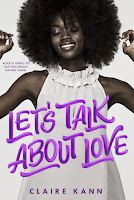What is your favorite book?
As a librarian, I get asked this all the time. It’s a tough
question, I know. And it’s okay to have more than one answer! But indulge me
for a moment, and think of a favorite book or two.
Why are these books our favorites? What is it about them
that makes us like them?
Often, I enjoy books I can relate to. It doesn’t have to be
an exact replica of my life -- in fact, that might be pretty boring. But
there’s a special something when I can relate to the characters, locations, and
events in a book. The similarities I have with Harry Potter, for example, help
me enjoy his adventures in magic.
But some groups of people are not represented
proportionately in literature. For example, the multicultural publisher Lee and
Low Books released an infographic in May of 2018 based on statistics provided by the Cooperative Children’s
Book Center. Despite the fact that 37% of the United States’ population are
people of color (other races besides white), only 10% of children’s books
published since 1994 have authors, characters, or content who are Native or
people of color.
Why are so many voices silenced or ignored in literature?
There may not be clear answers, but everyone deserves to have their voice heard
and to see themselves in the pages of a book. Reluctant readers are more likely
to become enthusiastic about reading when they can relate to the books they
read.
In her 1980 article titled “Mirrors, Windows, and Sliding
Glass Doors,” Dr. Rudine Sims Bishop focuses on children of color who see the
world through the “windows” of books they read; however, the world they see in
literature is very different from the one they live in. Bishop said, “When
children cannot find themselves reflected in the books they read, or when the
images they see are distorted, negative, or laughable, they learn a powerful
lesson about how they are devalued in the society of which they are a part.” †
On the flip side of the coin, white children also suffer
when they are kept from the nature of the world they live in by the
underrepresentation of other races in literature. All can benefit from the
richness of human diversity; after all, variety is the spice of life. Below is
a list of books I personally have read that were written by or about people of
color or people from multicultural backgrounds.
This post is the first installment of Diverse Reads, a
series that gathers books with diverse characters or authors: people who are
LGBTQIA+, Native, people of color, gender diverse, people with disabilities, or
ethnic, cultural, or religious minorities. I hope that these books help open a
window for you into other worldviews.
Hoodooby Ronald L. Smith
(2015)
In 1930s Alabama, twelve-year-old Hoodoo Hatcher is the only
member of his family who seems unable to practice folk magic, but when a
mysterious man called the Stranger puts the entire town at risk from his black
magic, Hoodoo must learn to conjure to defeat him. This book shows various
elements of African-American culture that is often skimmed over or ignored, most
notably folk magic.
The Proposalby Jasmine Guillory
(2018)
When freelance writer Nikole Paterson is unexpectedly proposed to at a Dodgers
game, stranger Carlos Ibarra and his sister rescue her from the awkward
situation and the prying camera crews. Nikole hooks up with Carlos for a casual
relationship, but finds herself falling harder for him than she ever imagined.
A superb example of representation (with a black main character, a Latino love
interest, a black lesbian side character, and a Korean side character), this
book showcases the racial melting pot of modern-day Los Angeles.
Handa's Surprise
by Eileen Browne
(1994)
Handa carries seven delicious fruits to her friend Akeyo as
a surprise. But thanks to some hungry animals she meets along the way, it's
Handa who's in for a surprise! Giving an insight into Luo people of sub-Saharan
Africa, this older work depicts the flora and fauna of an environment that may
be foreign to many Western readers.
Mango, Abuela, and Me
by Meg Medina
(2015)
When Mia's abuela moves in with Mia and her parents in the city, Abuela can't
read the English words in Mia's bedtime stories. While they cook, Mia helps her
grandmother learn English. However, it is still hard for Abuela to learn the
words she needs to tell Mia all her stories. But a colorful parrot named Mango
might bring an unexpected solution to their communication problem. This book
accurately portrays the cross-generational language barrier that often arises
in Latinx immigrant families, like my own.
The Rent Collector
by Camron Wright
(2012)
Sang Ly struggles to survive by picking through garbage in
Cambodia's largest municipal dump. Under threat of eviction by an embittered
old drunk who is charged with collecting rents from the poor of Stung Meanchey,
Sang Ly embarks on a desperate journey to save her ailing son from a life of
ignorance and poverty. This book shows a rare view of the extreme poverty
rampant in contemporary Southeast Asia.
Hair Love
by Matthew A. Cherry
(2019)
A little girl's daddy steps in to help her arrange her
curly, coiling, wild hair into styles that allow her to be her natural,
beautiful self. This book highlights and extolls elements of Black culture that
are often ignored or even treated derisively in mainstream media.
† Bishop,
R. (1990). “Mirrors, Windows, and Sliding Glass Doors.” Ohio State University. Perspectives: Choosing and Using Books for
the Classroom, 6(3).
*A version of this blogpost first appeared on Provo City Library blog.*






























